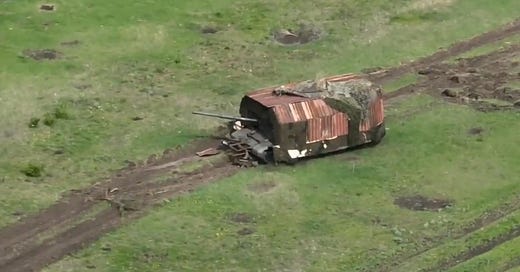70 Drone Strikes to Kill 1 'Difficult' Porcupine Tank
Anti-drone armor is awkward, but it works
The metal shells, grills, chains, quills and other improvised anti-drone defenses Russian regiments heap onto their dwindling few tanks are awkward and ugly and can block a driver’s view—and impede mobility.
But that doesn’t mean the armor doesn’t work. The extra protection can stand up to repeated strikes by the tiny explosive drones that are everywhere all the time along the 700-mile front line of Russia’s 41-month wider war on Ukraine.
One up-armored Russian “porcupine tank” recently survived more than 70 drone strikes before finally succumbing. “It was very difficult to find a weak spot,” the Ukrainian Deep State analysis group observed.
The tank was one of two involved in an assault on Ukrainian defenses outside the ruins of Toretsk, in eastern Ukraine’s Donetsk Oblast, on or before Wednesday.
“After months of continuous assaults by small groups, the Russians decided to go all-in,” the Ukrainian army’s 28th Mechanized Brigade reported. “In the morning, the scouts of the 3rd Mechanized Battalion noticed two tanks with infantry moving towards our positions.”
“And not just any tanks,” the brigade added, “but [tanks] sewn up so much that they were no longer barns, but entire bunkers. But when the 28th Mechanized Brigade and adjacent units got down to business, all this improvised armor only delayed the inevitable.”
The brigades damaged the porcupine tanks with artillery. That’s when the drones swarmed in: first-person-view models including some equipped with A.I. targeting plus a few bomb-dropping drones.
“After several hits, the tanks tried to disperse along the forest belts to safely land the infantry among the greenery,” the 28th Mechanized Brigade reported. “In the end, there was almost no one to land. And those who still managed to escape … were eliminated.”
One of the tanks was badly damaged. The other was destroyed. “The enemy still won’t stop on his own,” the brigade explained. “But he can be stopped.”
But at what cost? Ukrainian forces can’t afford to expend more than 70 drones on every Russian target. Not when the demand for drones continues to outstrip supply.
Rare tanks
It’s vanishingly rare for any Russian tanks—including porcupine tanks and their close kin, turtle tanks—to participate in direct assaults. The Kremlin has written off more than 20,000 combat vehicles and other heavy equipment in Ukraine and is preserving the surviving vehicles, potentially for future wars elsewhere in Europe.
In place of fully mechanized assaults, the Russians increasingly attack on foot or on motorcycles.
But that’s costly, too—in lives. 100,000 Russians have died in Ukraine since January. So it makes sense that some Russian commanders, reeling from recent heavy troop losses, might once again deploy armor.
A porcupine tank doesn’t just shelter infantry under it shell, it may also carry radio jammers and mineclearing gear. If the tanks can get through the Ukrainian artillery and drones, they may “clear the way for future assaults—in particular for motorcycles, et cetera,” Deep State noted.
In surviving around 70 drone strikes, that tank outside Toretsk very nearly helped the Russians cross the no-man’s-land and potentially secure a lodgement. And it may have reminded Russian commanders that heavy armor still has some value, even on a battlefield teeming with drones.
The Ukrainians have already internalized this lesson. They’ve selectively deployed up-armored tanks to blast unsupported Russian infantry—especially in Sumy Oblast in northern Ukraine, where the Russians have invaded with a large infantry force almost entirely lacking armored vehicles.
One Ukrainian tank, a Leopard 1A5, recently survived at least eight drone strikes before burning. Another Ukrainian tank, a Leopard 2A4, shrugged off 10 FPVs—one of which triggered an explosion in the tank’s external ammunition stowage.
The Ukrainian army’s 508th Separate Repair and Restoration Battalion fetched and repaired that tank.
Read more:
100,000 Russian Troops Died in Ukraine Between January and July
100,000 Russian troops have died in combat in Ukraine since the New Year, U.S. Secretary of State Marco Rubio revealed Thursday.






The second video plays fine, but all I get is a black screen for the first one. This happens in the Substack app on both my Galaxy S22 and Tab S8. Also in the browser.